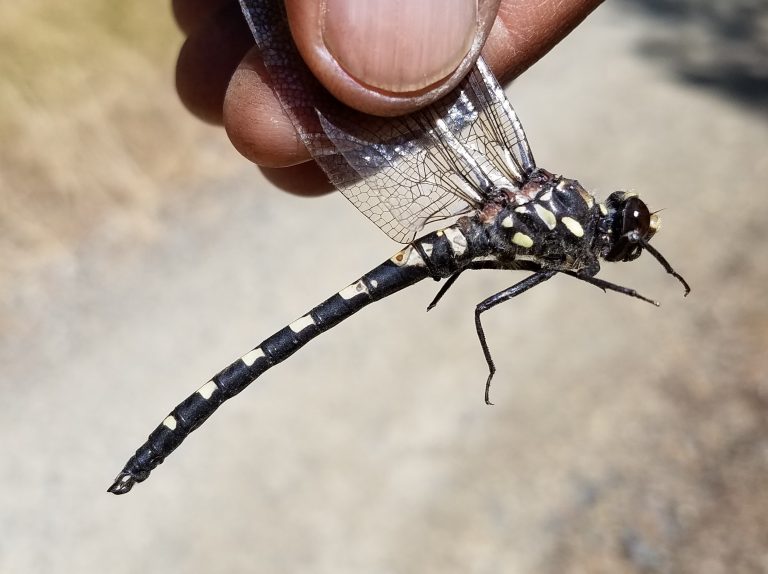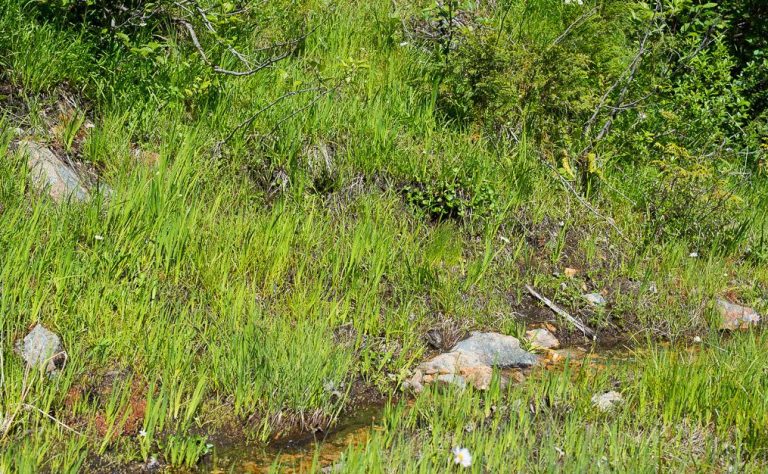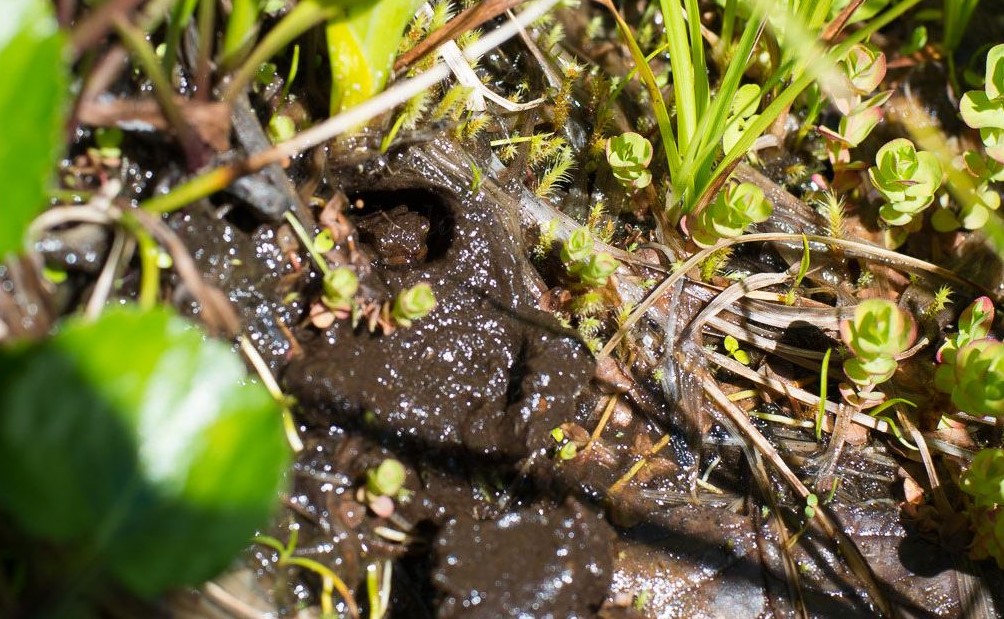Above: A Black Petaltail nymph peers out from its burrow in a mucky seep in British Columbia, January 25, 2014 (Photo by Stephane Pissavin). [ It’s just above and left of center. ]
The Dragonfly
The Black Petaltail (Tanypteryx hageni) is a member of a family of dragonflies (Petaluridae) that has existed since the Jurassic period (150 million years ago), with only eleven species remaining worldwide. In North America there are but two species, and in Oregon we have one, the Black Petaltail. Most unusual about the Petaluridae and specifically our Black Petaltail are the semi-terrestrial habits of the larvae and the long larval period. Whereas most odonates (damselflies and dragonflies) lay eggs in either pond or stream habitats and the larvae develop in one year or less, Black Petaltails breed in seepy bogs or fens, and the larvae take about five years to mature before emerging as adults for a brief part of one summer.
For some excellent reading on the Black Petaltail, see these three articles:
*Black Petaltail (Tanypteryx hageni), the Dragonfly of Soggy, Seepy, Slopes, by Jim Johnson
*On the Trail of the Black Petaltail, by Daniel Newberry
*A Dragonfly Apart, by Tom Kogut
Due to its habitat needs and life history and potential affects of forest management practices and climate change, the Black Petaltail is perhaps one of the most vulnerable odonates in the Pacific Northwest, yet relatively few sites are known for this species, particularly in the Umpqua Basin of SW Oregon.

The Project
The Oregon Conservation Strategy (OCS) identifies the Black Petaltail as a “strategy species,” because of its need for specialized habitat such as moist seeps. The OCS recommends to “…assess distribution. Improve understanding of species’ habitat requirements, including ability to use a wider range of habitat types than previously observed.
In 2018 I developed a study plan to address some of these questions in the Umpqua Basin (click here to download a copy). This plan includes my own field work as well basin-wide searches for the Black Petaltail by an army of volunteer Dragon Hunters! Searching for Black Petaltails will involve going to an assigned bog, seep, or meadow area once or twice from mid-June to early August (a great time to be in the Cascades!), looking for the dragonfly, and reporting your results (more on that later). Fortunately for us, the Black Petaltail frequently lands on the ground or on logs, so is relatively easy to find , observe, and even photograph. If this sounds like something you might want to be part of this summer, read on and sign up with the form below!

The Plan
This introductory blog post represents the first public step to involve volunteers in the study of Black Petaltails in the Umpqua Basin in 2019. The overall plan is as follows:
- Introduction and Volunteer Sign-up (this blog post)
- Identify Potential Sites (April and May)
- Assign Sites to Volunteers (April and May)
- Field Methods Training (May/June)
- Visit Sites (June to August)
- Data Analysis and Presentation (September to December)
If you would like to participate in this project either by helping me identify potential sites or searching for Black Petaltails in beautiful mountain meadows in early summer of 2019, or both, please sign up with the form below so I can provide more information and updates. (Note: as you scroll down you may also see a form pop up where you can sign up to receive email notification of all my blog posts–I hope you’ll do that too.

This Post Has 4 Comments
If, as mentioned above, this dragonfly takes 5 yrs to incubate, they should be hatching this year at Sru Lake; we observed them July 1, 2014 while having lunch along the lake.
What a coincidence! Just last week we drove to Sru Lake (formerly known as Squaw Lake), out of Powers, in the Roque-Siskiyou National Forest and were reminded of a time, a couple of years ago, we spotted these dragonflies in that very spot. At the time, we did not know what they were. I took pictures; will try to find them on my computer. Can’t remember, offhand, what time of year it was. https://www.fs.usda.gov/recarea/rogue-siskiyou/recarea/?recid=70098
It was July 1, 2014 when we saw these. Did not get a real good picture, but I remember the black and white striped body. There were also some brilliant orange dragonflies.
Sounds like fun